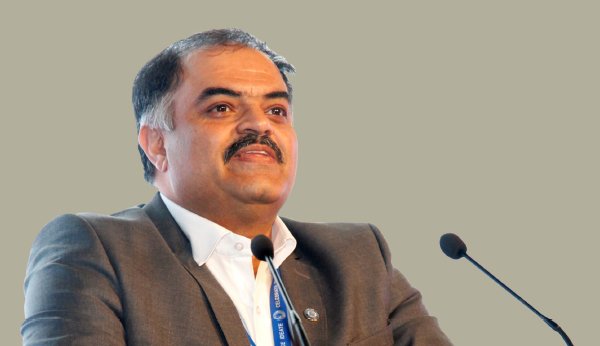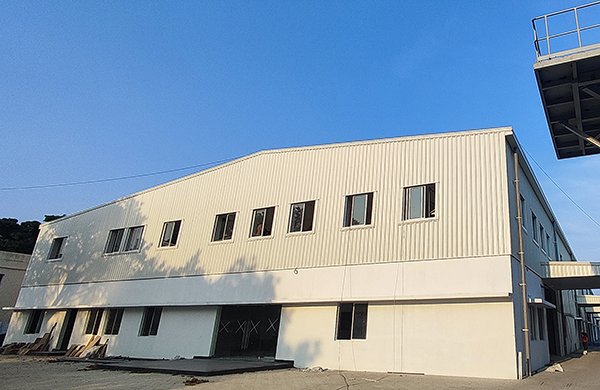In an exclusive interview with Steel Structures & Metal Buildings,
Sanjay S. Sahni, Executive In-Charge (Tubes Division), Tata Steel Limited, helming the steel tubes and pipes business of Tata Steel, shares the challenges faced by the steel suppliers in India, reasons that make Tata Structura the preferred choice of material, the future sections curated for the Indian market, and much more.
Excerpts from the interview…
Sanjay S. Sahni, Executive In-Charge (Tubes Division), Tata Steel Limited, helming the steel tubes and pipes business of Tata Steel, shares the challenges faced by the steel suppliers in India, reasons that make Tata Structura the preferred choice of material, the future sections curated for the Indian market, and much more.
Excerpts from the interview…
Inspired by the designs, we have constructed “The Agni” at Jamshedpur and intend to set up a few more sculpture across the country. Notions of India is an opportunity for architects, designers, and engineers to revisit, reimagine and recreate our nation’s heightened ambitions

Being one of the innovators of the steel industry, what is your take on the future of construction in India?
The Indian economy is rapidly growing and is being sustained not only by good infrastructural spending, but also by investments by businesses from both inland and abroad. Several initiatives, mainly in the field of affordable housing, expansion of railway networks, development of the domestic shipbuilding industry, and the opening of the defense sector for private participation along with the anticipated growth in the automobile sector is set to drive the rise in demand in construction space.
To support the growth aspirations of the Indian construction industry, structural steel is a natural choice as a construction material. Construction using structural steel helps deliver projects at much faster rates and enables clients to accrue benefits at a faster pace. In modern buildings, where large column-free spaces are a prerequisite for occupancy, structural steel is best suited to meet the safety and budget requirements of any project.
Owing to these reasons, we have observed over the past few years an increasing trend of steel usage in both residential and commercial sectors. With the growing confidence of architects and the engineering community in structural steel, we can expect a boom in steel-based construction in our country.
How would you describe Tata Structura’s success story?
Tata Structura has spearheaded the use of hollow steel section (HSS) usage in structural steel construction in our country. Tata Structura shaped the steel construction market by adopting HSS usage from conventional angles and channels. The usage of HSS not only makes projects economical, but also delivers sound aesthetics that serves as an inspiration for many budding architects and engineers. Through deep engagement activities with leading architects and engineers in our country, we have successfully included Tata Structura in many prestigious projects.
Tata Structura has been used in the construction of more than 40 airports (50,000 MT), 7 metro projects, more than 20 stadiums and iconic projects like the Statue of Unity, Ahmedabad; Butterfly, Bangalore; IKEA Showroom, Hyderabad; Infosys Building, Pune; Kolkata Gate; Patna Convention Centre; along with upcoming projects like Milan Mela Redevelopment, International Convention Centre, Kolkata, numerous data center projects, etc. In short, we can proudly say that Tata Structura has played a transformational role by supporting the dream projects conceived by the architecture and engineering community, and we will strive to provide exceptional services in the days to come.
What role have Tata Structura’s innovative products played in changing the industry scenario?
One of the emerging trends in the construction space that is set to dominate is the need for large column-free space. In the urban and semi-urban centers, there is a requirement to access the vertical space for both storage and occupancy. From a design perspective, many clients are preferring minimalistic yet elegant designs with exposed structural systems. Sustainable and environment-friendly construction concepts are fast picking up in our country. To support such emerging needs, as structural steel suppliers, we need to equip ourselves by developing high-strength steel materials and enhance our product range. Foreseeing such requirements from the construction industry, for the first time in the country, we introduced the YST 355 HSS in the Indian market in 2016 which has helped shape prominent landmark projects. For key project requirements, we have gone a step further and developed capabilities and supplied YST 420 grade steel.
We have also increased our product range and are now able to produce sections such as 400×400, 400×200 and 600NB pipes up to 16mm thickness which continues to find its applications in many mega projects. With the adoption of concepts like composite structures and concrete-filled tubes, such sections have a huge potential in regular residential and commercial structures.
Moving forward, we are in the process of enhancing our capabilities to produce 500×500 sections as well. Our products and manufacturing process have been thoroughly assessed and awarded with GreenPro and EPD certifications. With such strong sustainability credentials, green buildings can now be built easily using Tata Structura, and with the ability to serve larger sections and higher-strength steel, Tata Structura would be able to support the growth aspirations of our country in a sustainable way.
What are the key challenges faced by Indian steel suppliers? How do you plan to tackle it?
A One of the key challenges we face in the structural steel industry is the slower adoption rate of new products that in some ways leads to a catch-22 kind of a situation. Any new product, whether in terms of the section size range or higher yield strength steel, when it takes a longer time to adopt, leads to lower order volumes which in turn, discourages production as it does not meet minimum campaign volumes.
Any extra material produced usually tends to move into high-age stock and incurs a heavy loss. Creating awareness and deeper engagement with architectural as well as the engineering community across the country will drive faster adoption of such new products in the design. Often, we closely work with leading research institutions for design assistance that boosts the confidence of the clients while using such new products in their projects.
Tata Steel has launched a design competition Notions of India. How would this novel initiative help the steel construction Industry?
Back in 2007, Tata Structura had commissioned a nationwide design competition “Notions of India” for architects to design iconic sculptures using HSS. The competition received tremendous response across the country and culminated in the construction of “The Charkha” in Mumbai. In 2021, the second edition of Notions of India was organized around the theme “Shaping a billion dreams”. We received a multitude of mesmerizing designs from sculpture from across the country. Inspired by the designs, we have constructed “The Agni” at Jamshedpur and intend to set up a few more sculptors across the country. Notions of India is an opportunity for architects, designers, and engineers to revisit, reimagine and recreate our nation’s heightened ambitions. The intention is to be a vehicle to propel the many different ideas and innovations of the architectural and engineering fraternity into envisaging the symbols that capture the essence of our country and further inspire its citizens to achieve higher things in life.
What steps should be taken by the government to promote steel construction in India?
The Ministry of Steel has been very active in promoting the usage of structural steel in India. Setting up the INSDAG organization has played a crucial role for engineering students and design firms to learn designing using structural steel. Intense research activities are being conducted at institutes like IITs and SERC on structural steel. We believe it would help the steel construction space if all the published research documents could be collated, standardized in the form of guidelines or codes and made easily accessible. The knowledge dissipation will further boost the confidence of structural engineers in adopting structural steel and effectively designing their projects. It would benefit greatly to include advanced fabrication and installation processes in the curriculum for engineers, leading to having a ready subject and industry knowledge when they graduate.
What is Tata Steel’s plan of action for the next five years?
Tata Steel would like to focus on equipping the construction industry to adopt new products and services and continue to enhance our product range to meet the aspirational needs of the country. We will continue to collaborate with clients, architects, and engineers to help with design optimization support of steel structural systems. Increasing knowledge about new technology and tool adoption like automated profile cutting is very important to improve fabrication and enhance our infrastructural development. We also plan to pursue the optimization of designs by using new-age technologies like CFT (concrete filled tubes), composite systems, diagrid and space frame systems, etc. We recognize the need for protecting our environment and support the cause by continuously improving our products to help build a greener future.
What message would you like to give our readers?
The per capita steel consumption is a direct indication of the development of a country. The per capita consumption of steel in India is 75 kg whereas the world’s average is at a level of 230 kg according to 2019 data. Steel construction allows a tremendous reduction in project execution time and instigates improved quality while offering sound safety and sustainability standards. Overall, material quality, durability, life cycle cost and recyclability play an important role in construction and steel has hardly any competition in that area. So, we want to encourage our readers to adopt structural steel in their projects and in some ways contribute to the acceleration of the development of our country.






